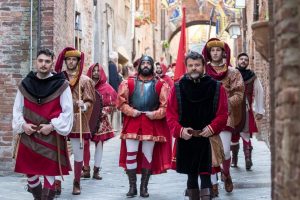 Everyone’s heard of the famous Palio of Siena held in the summer that attracts thousands of visitors, but have you heard of a second palio? Yes, that’s right. The town of Torrita di Siena, just outside of Siena, holds another palio race every year in March with similar features, except for the animals racing are not horses, but donkeys. The event was born in 1966, when a village association established it as a popular festival in honor of the patron saint of carpenters, St. Joseph. (In Italy, Father’s Day also coincides with St. Joseph’s Day). It was understood that it would also serve as a meeting place for all the emigrants of Torrita di Siena who in the past, generally for work reasons, were forced to leave their country of origin and move elsewhere. The dedication to St. Joseph is due to the fact that in Torrita di Siena woodworking has a history of being a prized artisan craft. The festival showcased the fatigue and simplicity of human work, so it made sense that the donkey, a humble and above all tireless animal, was chosen as a symbol.
Everyone’s heard of the famous Palio of Siena held in the summer that attracts thousands of visitors, but have you heard of a second palio? Yes, that’s right. The town of Torrita di Siena, just outside of Siena, holds another palio race every year in March with similar features, except for the animals racing are not horses, but donkeys. The event was born in 1966, when a village association established it as a popular festival in honor of the patron saint of carpenters, St. Joseph. (In Italy, Father’s Day also coincides with St. Joseph’s Day). It was understood that it would also serve as a meeting place for all the emigrants of Torrita di Siena who in the past, generally for work reasons, were forced to leave their country of origin and move elsewhere. The dedication to St. Joseph is due to the fact that in Torrita di Siena woodworking has a history of being a prized artisan craft. The festival showcased the fatigue and simplicity of human work, so it made sense that the donkey, a humble and above all tireless animal, was chosen as a symbol.
 The current palio is run by eight competing districts: Porta a Pago, Porta a Sole, Porta Gavina and Porta Nova, Stazione, Refenero, Le Fonti and Cavone. In the past during the week preceding the actual palio, medieval dances were organized in the historic center, duels between knights, performances by archers and falconers, jesters, jugglers and storytellers.
The current palio is run by eight competing districts: Porta a Pago, Porta a Sole, Porta Gavina and Porta Nova, Stazione, Refenero, Le Fonti and Cavone. In the past during the week preceding the actual palio, medieval dances were organized in the historic center, duels between knights, performances by archers and falconers, jesters, jugglers and storytellers.

The flag festival takes place on Sunday, March 17th this year when flag-bearers and tambourines from all over Italy perform. During those same days the four taverns (Nencia, Ponticino, Da Ghino and Pagone) managed by the eight competing districts also open and serve Tuscan specialties. A typical pasta dish called Pici della Valdichiana or the Chianina veal steak are just two of many. There’s also the presentation of the palio (a hand painted banner that must be designed with specific details including the image of St. Joseph).
During the two days preceding the race all the districts hold conciliatory dinners. On the day before the event there is a medieval banquet and the blessing of the palio, the performance of the flagship and tambourine school of Torrita di Siena and, finally, at night, a competition in pairs between the flag-wavers and the tambourines of the eight districts.
 On the morning of Sunday, March 24th, the eight districts present themselves in the square of the historical center of Torrita di Siena and, after attend the holy Mass officiated in the ancient Romanesque church of Santa Flora and Lucilla. After the competition, the districts form a procession that parades through the ancient streets of the town. Medieval knights and archers bearing the ancient crests of Torrita di Siena and its four castles along with a band playing the palio’s hymn wind through the ancient cobblestone alleys.
On the morning of Sunday, March 24th, the eight districts present themselves in the square of the historical center of Torrita di Siena and, after attend the holy Mass officiated in the ancient Romanesque church of Santa Flora and Lucilla. After the competition, the districts form a procession that parades through the ancient streets of the town. Medieval knights and archers bearing the ancient crests of Torrita di Siena and its four castles along with a band playing the palio’s hymn wind through the ancient cobblestone alleys.
The competition field is set up in the open space of the Gioco del Pallone, outside the ancient city walls of Torrita di Siena. In the early afternoon, after the entrance of the palio and the districts, the tambourines and flag-wavers of each district repeat their performance in front of the public in the stands. Subsequently the best pair of flag-wavers and tambourines is awarded.
Before the real race begins, the public will draw in order to select the eight donkeys for the respective districts, which will compete in pairs in four elimination rounds. The four districts who manage to pass to the next round are admitted to the final challenge. The winning district of the race wins the banner (the palio) and bragging rights for the entire year.
photo copyrights: sienafree.it, visittuscany.com, Marco Mazzolai, lavaldichiana.it

